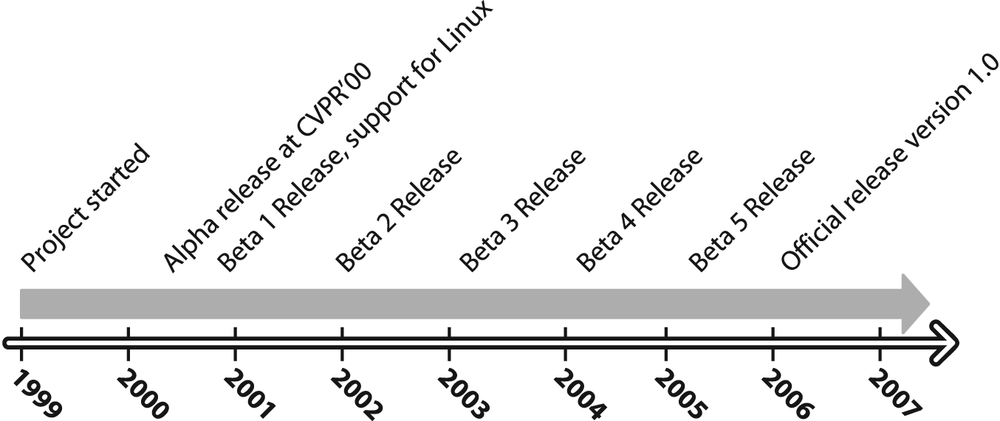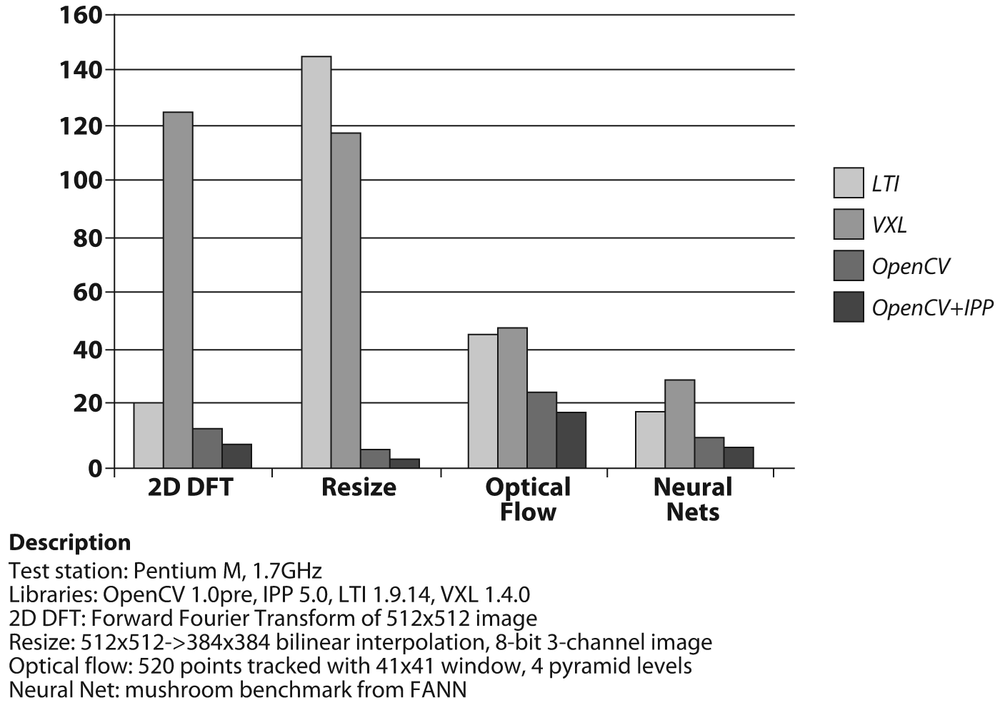OpenCV grew out of an Intel Research initiative to advance CPU-intensive applications. Toward this end, Intel launched many projects including real-time ray tracing and 3D display walls. One of the authors working for Intel at that time was visiting universities and noticed that some top university groups, such as the MIT Media Lab, had well-developed and internally open computer vision infrastructuresâcode that was passed from student to student and that gave each new student a valuable head start in developing his or her own vision application. Instead of reinventing the basic functions from scratch, a new student could begin by building on top of what came before.
Thus, OpenCV was conceived as a way to make computer vision infrastructure universally available. With the aid of Intel's Performance Library Team,[3] OpenCV started with a core of implemented code and algorithmic specifications being sent to members of Intel's Russian library team. This is the "where" of OpenCV: it started in Intel's research lab with collaboration from the Software Performance Libraries group together with implementation and optimization expertise in Russia.
Chief among the Russian team members was Vadim Pisarevsky, who managed, coded, and optimized much of OpenCV and who is still at the center of much of the OpenCV effort. Along with him, Victor Eruhimov helped develop the early infrastructure, and Valery Kuriakin managed the Russian lab and greatly supported the effort. There were several goals for OpenCV at the outset:
Advance vision research by providing not only open but also optimized code for basic vision infrastructure. No more reinventing the wheel.
Disseminate vision knowledge by providing a common infrastructure that developers could build on, so that code would be more readily readable and transferable.
Advance vision-based commercial applications by making portable, performance-optimized code available for freeâwith a license that did not require commercial applications to be open or free themselves.
Those goals constitute the "why" of OpenCV. Enabling computer vision applications would increase the need for fast processors. Driving upgrades to faster processors would generate more income for Intel than selling some extra software. Perhaps that is why this open and free code arose from a hardware vendor rather than a software company. In some sense, there is more room to be innovative at software within a hardware company.
In any open source effort, it's important to reach a critical mass at which the project becomes self-sustaining. There have now been approximately two million downloads of OpenCV, and this number is growing by an average of 26,000 downloads a month. The user group now approaches 20,000 members. OpenCV receives many user contributions, and central development has largely moved outside of Intel.[4] OpenCV's past timeline is shown in Figure 1-3. Along the way, OpenCV was affected by the dot-com boom and bust and also by numerous changes of management and direction. During these fluctuations, there were times when OpenCV had no one at Intel working on it at all. However, with the advent of multicore processors and the many new applications of computer vision, OpenCV's value began to rise. Today, OpenCV is an active area of development at several institutions, so expect to see many updates in multicamera calibration, depth perception, methods for mixing vision with laser range finders, and better pattern recognition as well as a lot of support for robotic vision needs. For more information on the future of OpenCV, see Chapter 14.
Because OpenCV was "housed" within the Intel Performance Primitives team and several primary developers remain on friendly terms with that team, OpenCV exploits the hand-tuned, highly optimized code in IPP to speed itself up. The improvement in speed from using IPP can be substantial. Figure 1-4 compares two other vision libraries, LTI [LTI] and VXL [VXL], against OpenCV and OpenCV using IPP. Note that performance was a key goal of OpenCV; the library needed the ability to run vision code in real time.
OpenCV is written in performance-optimized C and C++ code. It does not depend in any way on IPP. If IPP is present, however, OpenCV will automatically take advantage of IPP by loading IPP's dynamic link libraries to further enhance its speed.
Figure 1-4. Two other vision libraries (LTI and VXL) compared with OpenCV (without and with IPP) on four different performance benchmarks: the four bars for each benchmark indicate scores proportional to run time for each of the given libraries; in all cases, OpenCV outperforms the other libraries and OpenCV with IPP outperforms OpenCV without IPP
Although Intel started OpenCV, the library is and always was intended to promote commercial and research use. It is therefore open and free, and the code itself may be used or embedded (in whole or in part) in other applications, whether commercial or research. It does not force your application code to be open or free. It does not require that you return improvements back to the libraryâbut we hope that you will.
[3] Shinn Lee was of key help.
[4] As of this writing, Willow Garage [WG] (www.willowgarage.com, a robotics research institute and incubator, is actively supporting general OpenCV maintenance and new development in the area of robotics applications.
Get Learning OpenCV now with the O’Reilly learning platform.
O’Reilly members experience books, live events, courses curated by job role, and more from O’Reilly and nearly 200 top publishers.



